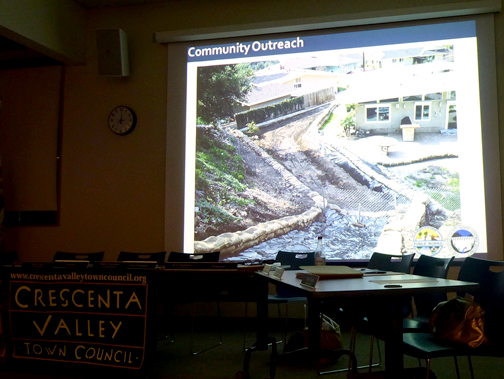
An LA County Flood Control District representative explained how the district is preparing for upcoming storms.
By Julie BUTCHER
Engineers from Los Angeles County Flood Control District made a presentation at the February meeting of the Crescenta Valley Town Council that focused on safety preparations the agency is making in anticipation of upcoming storms.
Stormwater Division principal engineer Sterling Klippel reported that the county’s immediate work is aimed at preventing dangerous debris flows such as were experienced in areas affected by recent fires including the Oro Vista Fire, the La Tuna Fire and Creek Fire.
“Our fires here are more intense and have become more frequent,” Klippel said. “It takes the watershed five years to recover from fires like these. Our first concern is about safety.”
Sharing a slideshow and video presentation, Klippel explained what the flood control district has been doing since the fires to protect the community from all possible hazards.
“We constructed temporary structures after the fire, K-rails and barricades, to guide the massive debris where we want it [to go] instead of into your backyard. Our mission is to provide sustainable water supplies and healthy watersheds while reducing flood risk for our communities,” Klippel read from the PowerPoint slide. “And our aim is the conservation and preservation of locally sustainable water. We oversee dams and facilities built in the 1920s and ’30s, so we’re lucky that they built spreading grounds for rain and stormwater to percolate in order to replenish our groundwater supplies. One-third of our local water comes from under our ground so we work hard to maintain a local, sustainable water supply.”
He added that in 2017 local dams refilled due to the amount of rain that fell. In anticipation of the hoped-for rains this year, fire debris is being moved “as quickly as we can” to get ready for the rain.
“Please watch for announcements of the trucks moving debris and sediment through your streets. We’re working with your local officials and the town council to avoid busy times and active areas, but it’s important that we clear these areas,” Klippel said. “It is our intent to do this with minimal impact to the community.”
LA County Dept. of Public Works reports that the flood control district oversees more than 2,700 square miles and approximately 2.1 million land parcels within six major watersheds. It includes drainage infrastructure within 86 incorporated cities as well as the unincorporated county areas. This includes 14 major dams and reservoirs; 483 miles of open channel; 27 spreading grounds; 3,330 miles of underground storm drains; 47 pump plants; 172 debris basins; 27 sediment placement sites; three seawater intrusion barriers; and an estimated 82,000 catch basins.
For more information about the LA County flood control district, visit www.dpw.lacounty.gov/LACFCD.
